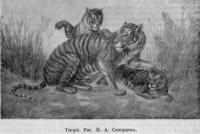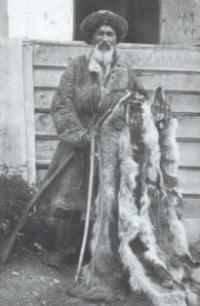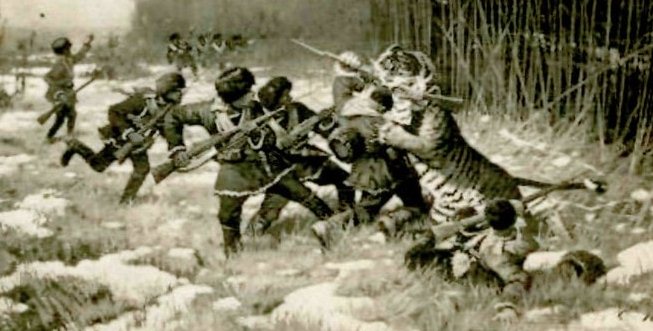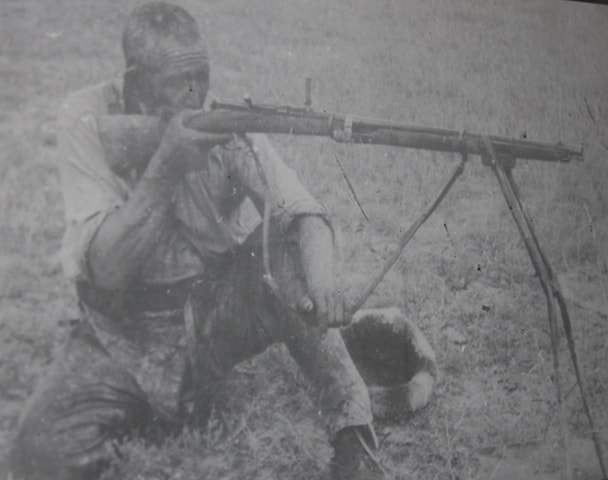You are here
Tiger hunting in Issyk gorge.



Best photo tours in mountains of Trans-Ili Alatau
“Everyone who was sleeping in the yurt ran out of it, except for me and the Sultan, who was sleeping soundly beside me on his silk pillows and barely waking up after me. A few minutes after that, a loud shot rang out near the yurt itself, and I could recognize the cause of the alarm, since all the Kyrgyz, recognizing the night guest, shouted: "Ayu", "Ayu"; it was a bear that had climbed into a herd that was grazing a few steps from our yurt, which was pushed far ahead of the whole village. Frightened by the shot of my escort Cossack, the bear undertook a quick retreat, having kidnapped only one ram"
“At the beginning of the 20th century, the Turanian tiger was found in Central Asia and the Transcaucasus. These animals, say zoologists, lived near the villages, but did not attack people. In the 70s, it was officially recognized that the Turanian tiger had disappeared as a species.
Reasons: destruction of habitat - tugai forest, destruction of animals that tigers used to eat, grazing, taking water from rivers near which tigers lived (Amu Darya, Syrdarya, Chu, etc., and so on) and hunting them.
It is known for certain that in the town of Verny (the old name of Almaty) in 1913, a tame tiger, brought as a cub from Balkhash, lived with the forester Perovsky. Leon Trotsky, exiled to Alma-Ata in 1928, admired these royal animals. In addition to the well-known political statements, Trotsky signed a serious "Pact on non-aggression against the Balkhash tigers." The last Turanian tiger in the vicinity of Tashkent was killed in 1906 by the Russian prince Golitsyn.
A stuffed animal adorned one of the halls of the Tashkent Museum of Nature until the middle of the 60s of the 20th century, until a fire in the museum destroyed the exposition. In Tajikistan, the tiger was last seen in 1954.
According to the World Wildlife Fund, in northern Kyrgyzstan, the last animal of this species was destroyed in 1980. In the 1960s, the Turanian tiger was included in the Red Book of the International Union for Conservation of Nature. But it was too late. Attempts are now being made to revive this species in Kazakhstan. Local scientists, together with the World Wildlife Fund (WWF), have developed a special reintroduction program."
Living Asia. Marina Mikhtaeva
Photo hunting of Northern Tien-Shan mountain
The Issyk Valley serves as one of the best entrances to the best in its kind areas of the Zailiyskiy Alatau. They told me so much about the waterfall located in the Issyk valley, and about the beautiful Alpine "Green Lake" (Dzhasyl-kul), which is easiest to reach along the Issyk valley, that I decided, leaving my squadron at the place of half a day, to do it, accompanied by three escorts Cossacks and three hunters excursion to the valley.
We left at about noon. At first, the valley headed directly to the south, between the rounded hills. The forests of apple trees and apricots were getting thicker and thicker. Soon, to our right, the entrance to a side valley opened, into which I decided to call with my companions, since it was extremely narrow and picturesque. High, but rounded mountains, bordering it, rose on both sides, one after the other, like a curtain. They are also overgrown with dense thickets of apple trees and apricots.
Despite the autumn season, everything in it was fresh and green, like in a beautiful garden. The apple trees were covered with ripe apples, but the apricots were already gone. The ascent along the valley was rather steep and difficult.
The Cossack hunters accompanying us were not disappointed in their expectations, and when we drove from the zone of fruit trees to the zone of coniferous forests, which consisted of slender fir trees, and then of juniper (Juniperus sabina), we really scared two tigers out of the dense thickets of juniper.
Everyone rushed to chase them, but, of course, without any chance of success, and, having driven three versts into the mountains, I decided to turn back with my escorts to the Issyk valley. Cossack hunters parted with us, wishing to hunt down the tigers and continue the hunt, which, in their opinion, had begun so successfully. I, with my escorts, returned to the Issyk valley and began to climb it.
The mountains became higher and closer, and slender spruces (Picea schrenkiana) appeared in front of us on their slopes. Finally, at the fifth verst, sheer cliffs and talus appeared. The rock that made up the mountains bordering the valley turned out to be red quartz free porphyry.
The peaks of the mountains that formed the valley, which later turned into a narrow gorge, were, however, rounded and domed. Almost nothing was found in talus and boulders, except for porphyry, and only occasionally did we find pink and white with black syenites.
Four times we had to move to the frenzied ford Issyk to bypass the steep cliffs that rise on the one and then on the other side of it. The fords were deep and extremely dangerous, since horses in the most impetuous places of a stormy stream, stumbling over pitfalls, could easily be knocked down and carried away by foaming waves.
In one place, such a wave overturned one of our horses that had stumbled over a rock. Fortunately, the Cossack, who was sitting on it, managed to jump onto the rock, not flooded by the waves of a stormy stream, and we soon managed to pull the horse, stuck between the rocks near the shore, out of the water.
Finally, at the end of the wild gorge, a waterfall appeared, descending as a wide silvery ribbon. The entire Issyk, like Gisbakh (in Switzerland), rushed from a long slope with ledges into a deep gorge, and only its top broke through a waterfall through a rocky recess, picturesquely bordered by dark green fir trees sticking out from rocky porphyry cliffs, partly covered with dark green juniper.
We could not get to the "Green Lake" on this trip, as there were still several miles of difficult ascent to it, and the sun had already disappeared behind the high mountains. I visited Lake Dzhasyl-kul only in the next year 1857, and on that day I hurried to return to our camp (when Issyk left the mountains), which we reached already in the moonlight.
The officers who were traveling with me along the way, I found here at an overnight stay after they had made a detour around the Kyrgyz auls. I was in no hurry with my departure the next day, since that day the crossing was going to be the easiest for me.
Having convinced myself during the pursuit of tigers, as well as during our four crossings across Issyk, that Cossack horses were completely unsuitable for mountain crossings, I decided at all costs to change all my horses. was considered mountaineers, since in the summer season they kept their herds on the most inaccessible heights of the Zailiyskiy Alatau. Such auls, at the direction of Colonel Khomentovsky, I could find on the Turgeni River, which was only fifteen miles from Issyk.
On September 4, getting up in the morning rather late after the tiring travels of the previous day, I learned about the sad outcome of the tiger hunt, at the beginning of which we tried to take part. In pursuit of the tigers, the three hunters finally attacked their tracks, which diverged in one place, since, apparently, both tigers ran along different paths.
One of the two older and experienced hunters with a dog set off along the upper path, an equally experienced old Cossack with a young one who had never been on a tiger hunt followed the other. Both parties did not lose sight of each other. Unfortunately, the Cossack, walking along the lower path without a dog, noticed a tiger lurking in the bushes, already too late to have time to shoot at him.
The tiger rushed at the hunter so swiftly that with a blow of his paw he knocked the rifle out of his hands. An experienced Cossack, without losing his presence of mind, stood in front of the tiger, which in turn also stopped and lay down in front of the hunter, like a cat that lays down in front of a mouse when it stops moving.
The young Cossack was in a hurry to help his comrade, but his hands were so numb with fear that he could not fire a shot. Then the senior Cossack demanded that he give him his rifle, but even this the young Cossack was not able to do; the old one turned around and took two or three steps in order to take his rifle from the young one.
At that moment, the tiger rushed to its prey and, grabbing the Cossack by the shoulder, pulled him forward with a strong movement, as he noticed that the third Cossack, walking with the dog along the upper path, was quickly running across its path.
The tiger had already managed to run across the intersection of the paths, but the dog managed to catch up with him and grab his back. Then the tiger, abandoning its prey, ran a little ahead and began to turn in order to throw off and tear apart its little enemy, which he finally succeeded in, but here he was struck by two lethal shots of the hunter pursuing him; however, he still had enough strength to go down to the stream, get drunk in it and breathe his last breath on its shore.
But the victorious shooter was no longer up to the tiger: he rushed to the aid of his comrade, whose one arm was gnawed above the elbow, and the other had two severely injured fingers. Both Cossacks carried their comrade in their arms to the place where they left their horses, and then with their help got to our lodging in Issyk.
With difficulty, the victim was transported to Vernoe, where only on my return from my two trips to Issyk-Kul, I visited him in the hospital and found him recovering, although he already had his hand was taken away.
The trophy of their hunt, a beautiful tiger skin, was handed over to me, and the amount I gave to the hunter who killed the tiger was generously given to them by their injured comrade.


Authority:
"Travel to the Tien Shan", P.P. Semenov-Tyan-Shansky. 1857.







